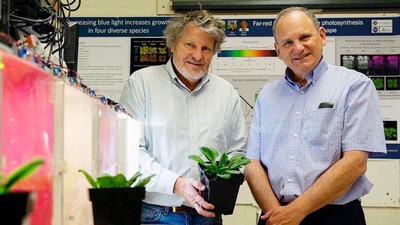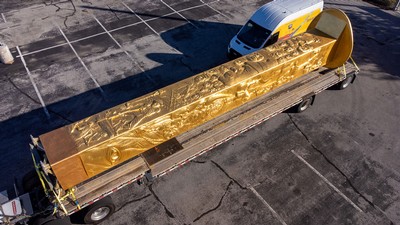USU Aggie Rec Center Named 2017 Outstanding Sports Facility
The student Aggie Recreation Center is an eye-catcher and an award-winner.
The chic brown and silver structure with its immense windows and sharp-jutting angles, is this year’s Outstanding Sports Facility by the National Intramural and Sports Recreation Association. The award was given Feb. 21 at its annual Conference and Campus Recreation and Wellness Exposition in National Harbor, Maryland.
Other awards and recognition the new rec center has garnered since its opening 15 months ago includes a coveted LEED Gold certification. It was named the Outstanding Sports and Recreation Facility for 2016 by Utah Design and Construction magazine. It received the 2016 Merit Award for recreation and sports facilities for Best Project by the Mountain States Region from Engineering News Record. It also received a 2016 merit design award from the Utah Masonry Council.
“These awards and recognition underscore the high-quality, collaborative effort put forth by everyone involved in designing and constructing this wonderful facility for our students,” said James Morales, USU vice president for Student Affairs. “We have every reason to be extremely proud of our Aggie Recreation Center.”
The USU recognition is especially meaningful considering there are 5,000 NIRSA members in the United States, including six NIRSA universities in Utah, says Chase Ellis, director of USU Campus Recreation.
The competition is steep for this kind of honor and bodes well for both USU’s outdoor recreation department and for the university as a whole.
Grand by design, it is a fitness and wellness center that reflects the mountains and valleys that surround it — a facility conducive to looking up and looking out while building up and working out. Even its acronym, “ARC,” speaks to its expansiveness.
“The unique thing about this building is how we are able to incorporate the Utah environment inside it,” Ellis says. “It really brings the outside and inside environments together.” The idea being that many of the activities the students do inside the ARC, such as running and climbing, find a natural extension along the trails and cliffs of nearby Logan Canyon.
Hanah Nickerson, a USU senior in dietetics from Cedar City, Utah, started at USU when the field house across the street was the main attraction for students to recreate. She still loves the old facility, but there was no looking back after looking up in the ARC.
“It’s so unique and big, especially coming from the field house,” she says. “I think just walking in you can see that it’s an inviting environment. It is nice. I like to work out here because we have the space, we have the equipment and the resources that we need, and I think it’s definitely eye-catching.”
She is not alone. The center recorded 137,926 total visits last fall. “We have had at least 50 percent of the total student population come into the building at least one time, compared to a 15 to 20 percent national average,” Ellis says. “We’re just excited that the students love it and that so many of them are always here.”
And, apparently, more than just to exercise.
“Usually you don’t go to a rec center to study, but we actually have a lot of students that are in here in the evenings,” Ellis says. “Some are in the lounge; some are upstairs watching basketball games while others are studying. It’s really becoming a student-life building.”
Nickerson says the open space naturally encourages interaction, making it a perfect place to work out and hang out. “I love that people come here with their friends to work out together,” she says.
Whatever the reason for being there, anybody driving past the ARC, especially at night, can’t help but notice how a once quiet corner of campus on 700 East and 800 North, now buzzes with students.
“This is the center of campus in the evenings when classes are out,” Ellis says. “It can get crazy!”
“I love coming here,” says Phillip Lundell, who exercises at the ARC six days a week. He’s a senior from Salem, Utah, majoring in biological anthropology. “It’s just a great atmosphere that really brings the students together.”
Ellis says they are happy with the amount of use the facility is getting and that there is even more room to grow. The current structure is actually phase I. Phase II comes with an aquatic center. The plan, at least five years out, is to replace the current swimming pools in the Health, Physical Education and Recreation building, which are now nearly 50-years-old, and then add a wing that would attach the ARC to the back portion of the HPER.
In the meantime, students will just have to make do with their dazzling, outstanding and award-winning building.
ARC Fast facts:
- Opened Nov. 19, 2015, two years after construction began
- Hours open: 6-11 Mon-Thursday; 6-9 Friday; 8-8 Saturday; 2-7 Sunday
- Peak time: 4-9 p.m. weekdays
- Average time students spend at ARC: 45 min - 2 hours
- Building cost: $30 million. Paid for through student fees, which is why only current students may use the facility
- Designed by AJC Architecture of SLC and 360 Architects of Kansas City, Missouri
- Built by Layton Construction of SLC
- 105,000 square feet
- Three hardwood gym courts for basketball and volleyball
- 1/8-mile long elevated indoor track
- Multi-activity court for basketball, badminton and futsal
- 4,600 square-foot fitness center and three cardio lofts
- Cycling studio
- Two outdoor basketball courts
- Two outdoor sand volleyball courts
- Four group fitness studios for group exercise classes and open rec
- Student lounge
- Student locker rooms
- Hand-scanner used for student entry
- Most popular venue: climbing wall
- 60-80 fitness classes offered per week
Writer: John DeVilbiss, 435-797-1358, john.devilbiss@usu.edu
Comments and questions regarding this article may be directed to the contact person listed on this page.








